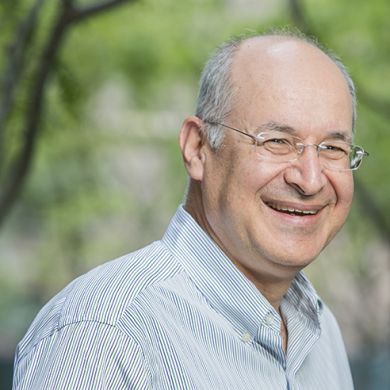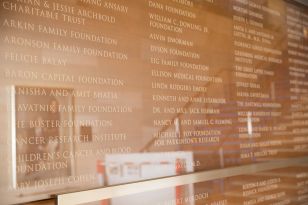Do I Have a Hidden Cancer?
We’ve all asked ourselves the question that Francis Barany, Microbiology and Immunology, Weill Cornell Medicine, is developing tools to answer. “It’s a scary question,” Barany says. “Do I have a hidden cancer within me?”
It’s also a difficult question—maybe the most difficult to answer in terms of what Barany calls the cancer problem. Cancer in its early stages, often asymptomatic, is most treatable but tragically most elusive to current expensive diagnostic technology. For many years, Barany and his collaborators have believed that the solution resides in testing the blood.
To translate academic research to the clinical setting, Barany cofounded a company, Acuamark Diagnostics, to develop highly sensitive assays and tests that detect early signs of cancer from a sample of blood. With Barany and his team, the company has developed its pilot assays to detect markers of colon cancer and is currently working to apply the basic principles to other types of cancer. Hopes are that detecting cancer at the earliest stages, in the blood, will be possible for the public as soon as three to five years.
Early-Cancer Detection Tests
Certain cancers have eluded early detection, and patients sometimes have to endure invasive tests such as colonoscopies, which carry risks and high price tags. For most cancers, there are no cost-effective tests that accurately and conveniently detect cancer at its earliest stages. The Barany lab and Acuamark Diagnostics hope to change that.
The challenge is a complex one. “Think of cancer as a garbage truck,” Barany says. “As the truck moves up the small side streets, occasionally it drops a piece of garbage behind it. A couple walking in the same neighborhood may see a plastic bottle on one street and a newspaper on another but not know where they came from,” Barany continues. “It’s only if they keep seeing more garbage that they may come to the conclusion that a garbage truck is making its rounds.”
Barany likens this process to trying to find early cancer. “We don’t know ahead of time what the garbage truck is actually going to drop, and each cancer drops different garbage into the bloodstream,” he says. “Not only that, but each individual’s garbage looks different. So this is really tricky.”
As lead inventor of the technologies at Acuamark Diagnostics, Barany and his lab team have developed new assays with heightened sensitivity and specificity, able to recognize and distinguish cancer’s various forms of garbage, also known as cancer markers. “Our assays can find different cancer markers at the single-molecule level,” Barany says.
Key to Acuamark Diagnostics’ system is a two-step testing approach, one that, Barany says, would avoid many of the pitfalls of previous attempts. “The first assay is a rapid assay that would be very low-cost and highly accurate,” he continues. “If you have 1,000 people, our hope is that the first assay will allow the physician to send 950 home until their next annual check-up.”
The blood samples of the 50 remaining patients would then undergo a series of sophisticated tests that “drill down very deeply,” Barany says. The pool of 50 would dwindle to about 15 to 20 people, who would then be recommended for further follow up. Only at that time would they proceed to the advanced testing and imaging currently being used at Weill Cornell Medicine and NewYork–Presbyterian Hospital.
“Statistically, 15 of the 1,000 patients really would have an early or a hidden cancer,” Barany says, “and detecting it early would vastly improve survival rates.” The assays would also be sensitive enough to help indicate the type of tumor, whether relatively slow-growing or aggressive, and would therefore aid in treatment decisions.
In addition, the early-cancer detection tests could reduce many of the false positives that the current diagnostic techniques are plagued with. “The total direct medical healthcare costs and the cost of lost productivity due to premature death from cancer in the U.S. are projected to reach $400 billion by the year 2020,” says Barany. “An early detection assay, by reducing false positives and detecting cancer before it spreads, could save the U.S. $300 billion, not to mention 300,000 lives every year.”
For the 15 patients who are diagnosed with cancer, their blood tests would have continued value. The tests would help to determine whether or not treatments are working and would monitor the blood post-treatment for signs of recurrence.
“As a next step, this technology will require high-quality clinical testing,” says Barany, “and the greater the resources, the better our ability to do that testing.” The teams at Weill Cornell and Acuamark Diagnostics are currently refining techniques and seeking support, with the aim of piloting the assays as soon as possible. “Our goal is to provide the best patient care in the U.S. and to make Weill Cornell Medicine one of the top institutions in the world for the treatment of early cancer.”
A Career’s Quest, Finding Disease Markers in the Blood
Among Barany’s scientific team members, a combined 150 years of research and achievement in diagnostic technology and drug development has paved the way for the development of the assays. Barany alone has been issued more than 50 United States patents. He has been honored as a Medical Diagnostics Research leader, Scientific American top 50 visionary, and Cornell University Ezra Innovator, among other accolades.
Some of Barany’s notable past contributions to the diagnostics industry have been the ligase chain reaction (LCR), ligase detection reaction (LDR), and universal DNA arrays to address some of the same questions he is working on today: how to identify disease markers in the blood. The LCR, LDR, and the universal array use an enzyme, ligase, to identify mutations or abnormalities in a sample. They are now widely used as a foundational technology for commercial tests—to diagnose many genetic diseases, pathogens, and cancer mutations.
Underpinning these technology developments is a 30-year history in Barany’s lab of identifying and studying the variety of DNA and RNA alterations that allow tumors to grow, specifically in colon cancer. Understanding tumor profiles, Barany says, has enabled better detection, smarter treatment, and the progress of diagnostic tools.
Collaborative and Translational, Research with the Widest Impact
“I was not always so interested in the clinical applications of my research,” says Barany, but a brush with mortality shifted him toward work that would have a wider impact.
“When I developed the ligase chain reaction, I wanted to collect more hot spring organisms to clone more ligases,” Barany explains. “I went to Yellowstone, and I had a terrible accident there, burning my leg very badly. After that accident, doing basic and academic research alone wasn’t enough.”
Barany began applying his research to more clinical problems. “I decided that I wanted to focus my research on areas where it would have the largest utility and widest impact. So I got involved with designing technologies that detect early cancer, because that really has the opportunity to save the most lives,” he says.
The name Acuamark Diagnostics was selected from a large pool of entries submitted by everyone involved with the company. “Each cancer leaves a unique watermark in our bodies,” says Barany. “As with a watermark, it is barely visible, requiring one to see it in a different light.”
This collective approach to naming the company embodies the essential role collaboration has played. “I cannot overstate the importance of the collective and cross-functional effort of the highest-quality professionals, both at the corporate as well as at the institutional level,” Barany says. “Without the combined strength, dedication, and hard work of team members in my laboratory, at Acuamark Diagnostics, and the support of the team at Weill Cornell Medicine, the progress to date would not have been possible. Today, we are much closer to answering the age-old question: Do I have an early cancer within me?”
This story first appeared on the Cornell Research site. Read the original here.




